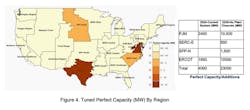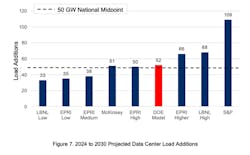The Grid Can’t Wait: DOE Report Underscores the Urgency for Flexible Power Solutions
The U.S. Department of Energy’s (DOE) recent Resource Adequacy Report delivers an eye-opening assessment of the country’s electric grid. Developed in response to Executive Order 14262, the report paints a stark picture of where our electric grid is headed, and it’s a trajectory that demands attention from every utility planner, operator and engineer in the country.
Using probabilistic modeling, the DOE outlines what will happen if we keep retiring dispatchable generation without replacing it fast enough. The bottom line: if we don’t course-correct, system reliability will fall short of planning thresholds across large swaths of the country by 2030. The consequences go well beyond brownouts. We’re talking about major risks to economic productivity, national security, and the continuity of critical services.
The data is sobering, but not surprising. The demand surges are driven by reindustrialization, electrification and the data centers powering artificial intelligence (AI), which means our firm generation base is shrinking. According to DOE modeling, the U.S. could see a 100-fold increase in annual loss-of-load hours if today's patterns go unchecked.
The report validates the growing need for scalable, flexible capacity solutions. If the U.S. wants to lead the AI arms race while reducing outage risk and lowering costs for communities and businesses alike, we need dispatchable solutions, not a complete grid overhaul.
A Perfect Storm of Grid Challenges
The DOE’s study used 12 historical weather years as the basis for stress testing three core planning scenarios for 2030:
- Plant Closures – Assumes all announced generator retirements (104 GW) occur, offset by expected Tier 1 additions
- No Retirements – Keeps all existing generation online through 2030
- Required Build – Assumes “perfect capacity” is added as needed to maintain reliability thresholds
In the first scenario, loss-of-load hours spike from just 8 per year to over 800. Normalized unserved energy increases by nearly 100 times. PJM, under some adverse weather conditions, would fall short of meeting demand in over 40% of hourly intervals.
Even in the "no retirements" case, regions like ERCOT, SPP and PJM still fall short, highlighting that it’s not enough to simply preserve existing capacity. We need to add firm resources, and fast. Any meaningful solution must account for regional differences in infrastructure, resource mix and grid stress patterns.
This Isn’t Just About Peaks Anymore
Historically, utilities have built their reliability planning around peak events, hot summer afternoons or winter storms. But the DOE’s modeling shows that grid stress is becoming a daily, systemic issue. Outage risk is now about whether we have the right resources on the grid, at the right time, every day.
One of the biggest drivers is the explosive growth in data centers. As AI applications scale, these facilities alone are expected to add up to 50 GW of new load nationwide by 2030. Compounding that scenario is sector-wide electrification, including industrial heating, electric vehicles and building systems that are all steadily increasing baseline demand. And finally, the grid is seeing higher penetration of renewables. While essential to decarbonization, having more weather-dependent generation means less predictable dispatch.
When the grid was being built, these immense power needs didn’t exist as they do now. The result is regional systems are under more frequent and sustained pressure. And that means utilities need resources that can ramp up quickly, dispatch reliably and respond dynamically to grid signals. The need for precision and flexibility in dispatchable resources has never been greater.
Real-World Lessons from Texas and Beyond
Events like Winter Storm Uri and Hurricane Beryl have already underscored the vulnerability of large, interconnected systems during extreme weather. But they also showed us that distributed, flexible generation can keep critical services online when centralized infrastructure falls short.
The DOE’s analysis confirms what these past weather events have already revealed. In ERCOT, resource adequacy is already below threshold levels. Without action, more regions will find themselves in the same position by the end of the decade.
For utilities, ISOs and planners, the report reinforces a need to:
- Reassess reserve margins using a probabilistic lens, not just static forecasts
- Consider non-wires alternatives like microgrids and distributed energy resources (DERs) in regional adequacy planning
- Include flexible, dispatchable generation, especially fast-ramping natural gas and hybrid solutions, as part of the reliability toolkit
Bridging the Gap
The Resource Adequacy report validates what many in the transmission and distribution world are already experiencing on the ground: the old models just aren’t keeping up. Load patterns are shifting. Planning windows are tightening. And the grid is being asked to deliver more with less margin for error.
If we want to increase capacity alongside integrating renewables without risking reliability, we can’t wait for the perfect answer or for long-term infrastructure to catch up. We need to invest in capacity solutions that are modular, fast to deploy and built to adapt to uncertainty.
In other words, we don’t just need more power, we need the right kind of power. Solutions that are available when needed, flexible enough to balance variable resources, and clean enough to align with the future of the grid.
The Takeaway for T&D Leaders
This is a pivotal moment for the industry. The next decade will challenge every assumption we’ve made about adequacy, planning and performance. Meeting those challenges will require a new level of coordination between system planners, regulators and technology providers, and above all else, a willingness to act before the next outage becomes a national crisis.
About the Author
Pete DiSanto
Pete DiSanto is the Executive Vice President of Data Centers at Enchanted Rock, where he leads the development of onsite generation and bridge power solutions for critical digital infrastructure. With more than 25 years of experience in the energy sector, including deep expertise in nuclear and fossil power, Pete joined Enchanted Rock in 2020 after two decades in operations and field service leadership. A frequent author and speaker, he advocates for positioning data centers as grid assets and advancing resilient, future-ready energy strategies.


